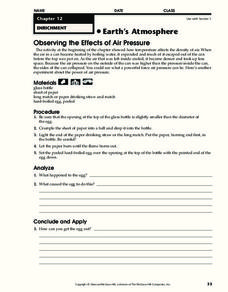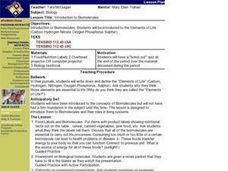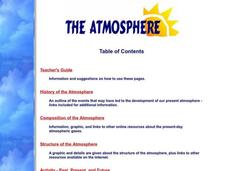Curated OER
The Origins and Maintenance of Earth's Atmosphere
For this atmosphere worksheet, students read over a data table showing the percentage of carbon dioxide, oxygen and nitrogen in the atmosphere over the last 4500 million years. Students create a graph comparing these gases over time and...
Curated OER
Water Quality
In this water quality worksheet, students complete a graphic organizer by understanding pH, temperature, oxygen, and turbidity as it relates to ideal water conditions.
Curated OER
Gases Around Us
In this gases instructional activity, students look at 6 pictures, put a rings around the gases in each picture and then name each gas or gases on the lines provided.
Curated OER
The Respiratory and Urinary System
In this body systems worksheet, students read information about the processes involved in the respiratory and urinary systems. Students then answer 1 short answer and 2 multiple choice questions.
Curated OER
The Chemistry of Life
In this molecule worksheet, students will use a diagram of a water molecule to see how many electrons and protons the molecule has and use a glycerol molecule diagram to discover carbon atom bonds. 5 fill-in-the-blank questions.
Curated OER
Water
In this water worksheet, students read an excerpt about the effects of pollution on the life cycle of a lake. Then they describe how lakes are affected by the pollution. Students also define why pollution has become such a problem for...
Curated OER
Earth's Atmosphere
For this Earth's atmosphere worksheet, students observe the effects of air pressure using an egg. They describe what happens to the egg and what makes it do what it does. Then they determine how to get the egg out of the bottle opening...
Curated OER
Fertilization to Birth
In this fertilization to birth process worksheet, students think about the changes a baby faces and complete the table on birthing trauma. They describe what type of trauma the baby might experience during the process of birth and what...
Curated OER
Significant Figures and Conversions
In this chemistry learning exercise, students identify how many significant figures are in each of the numbers listed. Then they determine the velocity in meters per hour for a subatomic particle. Students also determine how many...
Curated OER
Balancing Symbolic Equations
For this chemistry worksheet, students balance the listed equations by changing the coefficients. They identify and explain why iron bromide can react with water to produce iron oxide and hydrogen bromide.
Curated OER
Stoichiometry Worksheet I
For this chemistry worksheet, students explain how many moles of oxygen gas are needed to react with a certain number of moles of ammonia. They also identify how many grams of oxygen are needed to react with a certain number of grams of...
Curated OER
Introduction to Biomolecules
Young scholars are introduced to biomolecules and their roles in livin systems. They are introduced to the "Elements of Life." Students write down and define the "Elements of Life." They are asked why they think those elements are...
Curated OER
Cell Energy-Bubbling Plants
Students discuss the process of photosynthesis in plants and that oxygen is produced as a by product. They observe underwater Elodea plants "breathing" in a hands-on activity. After setting up the experiment, they observe the plant for...
Curated OER
How Fire Burns
Students observe teacher demonstration, discuss Fire Triangle, examine three things that fire needs to continue burning, including fuel, oxygen, and heat, and discuss how Stop, Drop, and Roll strategy is safest method of stopping...
Curated OER
Activity #7 Apple Color Change
Students compare the different rates of reaction between an apple covered with vitamin C and an apple with no vitamin C. They compare the different rates of reaction between an apple placed in the sun and one not exposed to the sun. ...
Curated OER
Photosynthesis: Intake of Carbon Dioxide - Production of Oxygen
Students, after a long-term observation of photosynthesis with aquatic plants, assess the benefits of photosynthesis towards all living organisms. They explain in their own words the two cycles within photosynthesis. Guided discussion...
Alabama Learning Exchange
Is My Water Safe?
Learners discuss what makes their drinking water safe and unsafe. They locate and visit a local tributary and test the water's pH, hardness, dissolved oxygen, and total alkalinity. They compose a summary paragraph about the tests and...
Curated OER
Down the Drain
Students explore what problems might occur if oxygen decreases in a body of water. They model what happens in a situation where decomposition is occurring. Students obtain, organize, graph, and interpret information. They i interpret...
Curated OER
Arbor Day
First graders study the importance of trees to our environment. they make their own version of the story by completing the following sentence and then completing an illustration for their writing. "A tree can be ______."
Curated OER
Move To a Healthier Aquatic Balance
Fourth graders examine aquatic orgnaisms and how enviromental chages affect them. This factors include: temperature, Ph, oxygen, nutrients, and pollutants. They also explore habitat quality (erosion). Students compile data and create...
Curated OER
Breathing and Asthma
Students investigate why asthma is a potentially life threatening disease. They follow the path oxygen travels as it enters the body and discover the causes of asthma and how your body reacts during an asthma attack.
Curated OER
Introduction to Dissolved Oxygen and Demonstration of a Simple Test Procedure
Young scholars explain the importance of dissolved oxygen in water ecosystems. They describe the aquatic oxygen cycle and the effect of water pollution on oxygen. They make observations, collect data and draw a conclusion.
Curated OER
The Atmosphere
Students calculate the percentage of oxygen in the atmosphere. They create a semi-scale drawing of the atmosphere.
Curated OER
The Heart
Students explore the parts of the heart and how blood travels throughout the body. They conduct a simple simulation to demonstrate the path that blood takes through the body and the functions it performs.

























